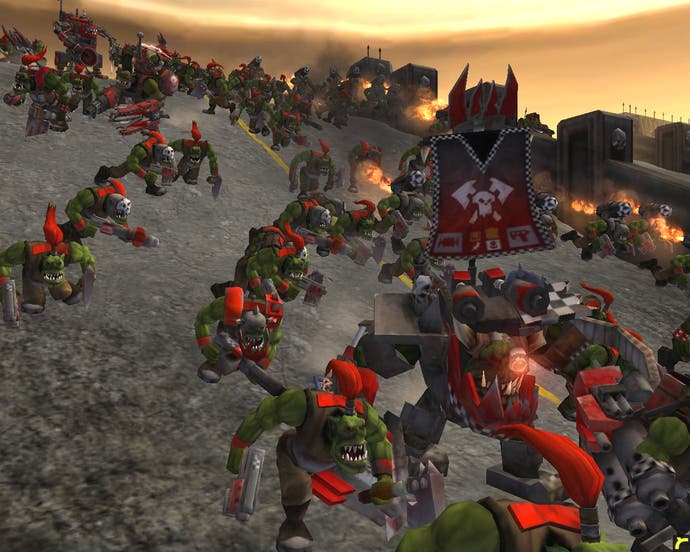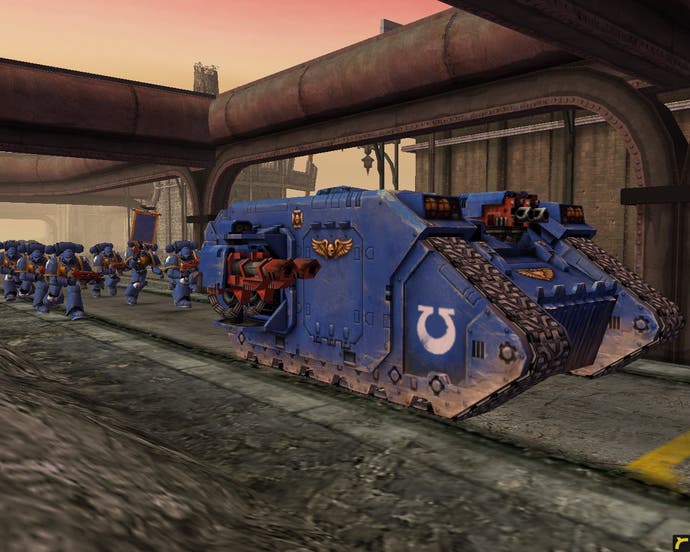Warhammer 40,000: Dawn of War
In the second part of the developer diary series, designer Chris Degnan at Relic Entertainment ruminates on "The Creative Process of Gameplay".

Hey there! I'm Chris Degnan, one of the designers on Warhammer 40,000: Dawn of War, and today I get to do a designer diary! As part of the Dawn of War design team I work closely with Jay [Wilson], the lead, and the other designers and get to poke my nose into a lot of cool stuff! For me, one of the most exciting aspects of the game development process has always been the creative process that goes into developing the game and all of its many bits and details. And that's what I'll be delving into in this here diary.
The creative process starts with the identification of the core ideas or goals of the game. In this case, we had this great licence in Warhammer 40,000, which is filled to the brim with bad-ass warriors with big guns and bloodthirsty enemies, and some really strong concepts for where we wanted go with our RTS game. So we took these concepts and the licence and outlined the bullet points that would define our core gameplay.
- Depict brutal, frontline combat in a manner never before seen in an RTS
- Make a game that appealed to the casual gamer without losing touch with the more avid RTS or Warhammer 40,000 fan
- Capture the feel and the energy of the Warhammer 40,000 universe
- Create a fun and compelling resource system
Once the core concepts were defined, numerous gameplay elements were filled in and the Proof of Concept, or POC, phase was entered. For the POC, we set about prototyping the look and the feel of our future game as well as the gameplay and core functionality behind our concepts. The goal of the POC is to find out whether our ideas work in practice before committing a full team and a couple years to the game. We try to shake out as many kinks as we can, prove all of our 'fun' things and highlight troublesome features that may give us grief or require further thought down the line.
Our prototype consisted of only one of our four races, the Space Marines, and only a fraction of their final inventory of units and buildings. But with that handful of units we were able to implement and test all of our basic gameplay features. With our Space Marine unit we were able to test the playability of squad based unit control, reinforcing squads in the field, upgrading weapons (only a missile launcher in those days) and modal infantry combat (that's when they use their guns at range and pull their combat knives out at close range). We had our builder to make our buildings. We had our basic vehicles to test our vehicle versus infantry balance. And we had our new resource system of Strategic Points to test the feasibility of an economy base around your military.
All in all, the POC went amazingly well. Armed with a working example of where we wanted our game to go, we hired some more talent and set about the construction of the game properly. Now in a prototype, a lot of what you do is done for expediency and a lot of the prototype assets must be set aside and be replaced by the real thing developed from scratch. By doing this we ensure that all of the art assets and gameplay features are done right without the potential limitations of rough prototype solutions.
As the phase of the development cycle shifts from planning to full production, the creative process changes from being very open ended and expansive to being a lot more focused on problem solving and getting the most out of our resources. At this point, as the programmers start to code all of the final features, the artists start churning out final models and animations for approval. And as the art assets are completed, they are dropped into the game with amazing results. Throughout this period, features are scrutinised to ensure they reinforce our core goals and we are always on the lookout to trim the excess work out of the schedule. The creative process isn't limited to just the game either, even the approach to constructing the tools we use to make the game can benefit from some creative thought.

For example, the Attribute Editor that the programmers provided for the designers was designed to grant direct access to the data that defines the stats for all of the units, abilities, and buildings in the entire game. Now when we have to change some stat so the Orks are worse at shooting and better at chopping, we don't have to bug anyone else, we can just step in and do it.
All of that hard work and planning in the early stages of development has led to something that we really feel delivers on our core vision. With a ton of effort put in by the artists and programmers, one can watch as ranks of armed combatants take aim and blow each other apart before charging in with swords and axes drawn to beat each other in close combat complete with stunning special attacks and vicious killing blows. Warhammer 40,000 fans and newcomers alike can feel the earth shake as buildings drop out of the sky, warriors in power armour clash with horrible aliens and monsters summoned from the warp stride into battle and stomp their foes to pieces.
We've focused very intently on the look and feel of the game, but we've also never lost sight of the tactical elements. You can quickly counter a special weapons squad by tying them up in close combat or use stealth abilities to get a quick peek inside your enemy's base. Fund your economy by capturing Strategic Points all across the battlefield or concentrate your resources by developing a set few. Will you spend all of your resources constantly reinforcing your existing squads as they get punished in battle or leave squads high and dry as you save up for the next big rush?
As players take to the field in Dawn of War the initial calm belies the carnage that waits just a few moments into the game. As the builders start frantically calling in and assembling the buildings, squads of basic infantry push out to capture points and secure resources. Soon the commander takes the field and leads the first charge against the enemy. Looking for any advantage, the players use superior numbers, cover bonuses or weapon upgrades to draw first blood. Then it becomes a mad dash to secure more points, maintain the existing forces while adding new units to counter the opponent's army. Soon the first vehicles rumble onto the killing fields, perhaps catching an unprepared foe completely by surprise and decimating infantry ill-equipped to deal with the new threat. But soon counters are called in and the battle again evens out. Before long, victory becomes a matter of who can protect their economy and maintain their military might while denying their opponent those same luxuries. And when death comes, it's a landslide of monstrous killing machines and hordes upon hordes of gun wielding warriors.
Since the project began, the reference material from the Warhammer 40,000 universe, both the fiction and the existing games, was overwhelming and we all benefited greatly from it. Working within such a dynamic and well-conceived universe has been absolutely awesome and the creative process that has led us to our current game has been incredibly rewarding.
Chris Degnan is a designer on Warhammer 40,000: Dawn of War. His views do not necessarily reflect those of Eurogamer or its staff. Warhammer 40,000: Dawn of War recently went gold and should be on store shelves in Europe from September 24th.

